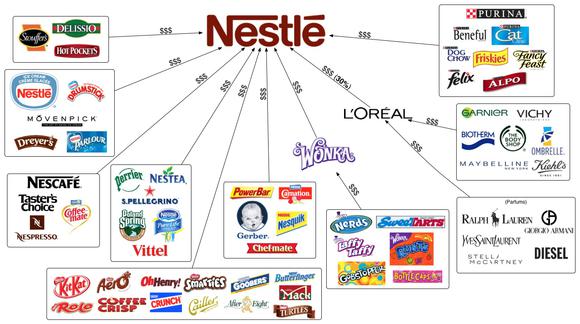America has one of the top economies in the world. Much of that is thanks to what we refer to as the “middle class.” The middle class, sometimes referred to as “the consumer,” has been driving American economic growth for the last few decades as illustrated in the chart below:

Source: Epoch Investment Partners
This trend has allowed various companies to build immense brand power as consumer staples to the “American Dream.” These trends are now starting to take hold in emerging markets whose economies have developed slower than that of the United States. “Middle classes” have started to grow in these lesser-developed economies, allowing the consumers to provide growth opportunities for these same American brands. These brands are a “shiny object” that are desired by emerging markets as they seek to mirror the consumer status displayed in middle-class America over the past several decades. The graph below shows consumer spending in emerging markets as of 2008 along with a projection for 2030 shown by the “outer rings:”

Source: jana.com
The below plays are wonderful businesses that will benefit from the macro-economic trends that the world will face over the next decade.
Have A Coke

The Coca-Cola Company (NYSE:KO) is driving its growth through emerging markets, it has seen a 5% growth in international volumes over this period last year. This includes:
18% growth in Thailand
8% growth in India
8% growth in Russia
3% growth in Mexico
3% growth in Brazil
This volume growth, combined with The Coca-Cola Company (NYSE:KO)’s 18.8% operation margin, equates to a stable source of cash flows. Coca-Cola has used this cash to reward its shareholders through 51 years of straight dividend increases at a clip of 9.8% per year over the last decade. While the growth at The Coca-Cola Company (NYSE:KO) has slowed a bit in recent years, the company should continue to increase it’s dividend by 5-8% annually.
Paying With Plastic
Visa Inc (NYSE:V) is the largest payment processing company in the world. With roughly 80% of the world’s transactions still done in cash, Visa Inc (NYSE:V) faces an excellent growth opportunity. The below graph shows the current projected volume growth of its international transactions:

Source: MSN Money
Visa Inc (NYSE:V) has seen a 20% increase in international transaction volume from 2012 to 2013 alone, with the primary source of this growth coming from the Asia-Pacific region.
Visa Inc (NYSE:V)’s business model is quite insulated from the current economic crises going on around the world. It’s earnings are protected from many side effects of macro-economic policies such as inflation due to the fact that Visa collects a percentage of every transaction – not a fixed amount. A second hedge from economic turbulence is the fact that Visa Inc (NYSE:V) does not lend consumers any money in their business dealings and the company is not responsible for any non-payment by its customers. This protects Visa from any falters in consumer credit.
The current high growth phase Visa Inc (NYSE:V) faces offers them the opportunity to put a lot of money in its shareholder’s pockets. Its three-year dividend growth rate is 31%, with plenty of room for further increases.
A Company That Provides For Almost Every Need Of Life
Nestlé is the world’s largest food conglomerate. It makes everything from candy, to frozen foods, to cosmetics, to dog food. Just take a glance below, and you will get an idea of how immense this company really is:

Is what is arguably the world’s most extensive consumer goods supplier not the ideal way to capture the growth of a new middle class in emerging markets? Emerging markets currently make up 45% of Nestlé’s sales. This number is expected by management to increase in time. As of its first quarter 2013 presentation, emerging markets saw organic growth of 8.4% from a year ago.
A handful of Nestlé brands are the “best in class” brands of the American consumer. This trend is being mirrored in emerging markets as management reports in its most recent presentation that market share is firming up in almost all categories ranging from Nestlé bottled waters to Nestlé pet care products.
Over the last decade, the company has grown earnings per share by 7.6%, and dividends by 12.5%. With this blue-chip-packed portfolio that includes 29 (!) billion-dollar brands, you will have a hard time finding a more stable income provider.
The bottom line:
The rise of a middle class in emerging markets presents an opportunity to investors. The consumer market is growing globally by 200,000 customers a day. We as consumers will continue to feed ourselves and our children, to wash ourselves, and to feed our pets. We will continue to wear make up, and to increase our credit card spending. Iconic brands of our past will be the foundation for our future. These companies are prime examples of opportunity to be found as the rest of the world embarks on its own version of the “American Dream.”
The article The Best Way to Play the Rise of the “Middle Class” in Emerging Markets originally appeared on Fool.com and is written by Justin Pope.
Justin Pope has no position in any stocks mentioned. The Motley Fool recommends Coca-Cola and Visa. Justin is a member of The Motley Fool Blog Network — entries represent the personal opinion of the blogger and are not formally edited.
Copyright © 1995 – 2013 The Motley Fool, LLC. All rights reserved. The Motley Fool has a disclosure policy.





